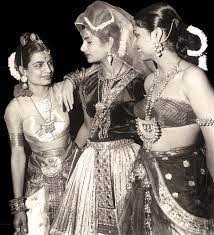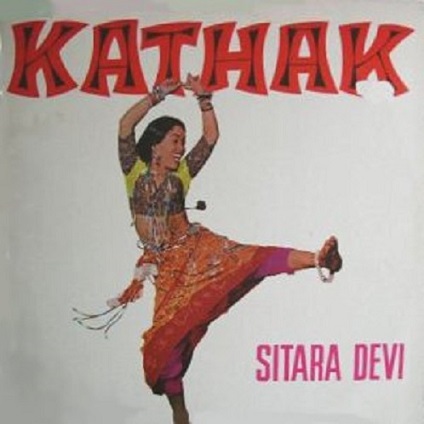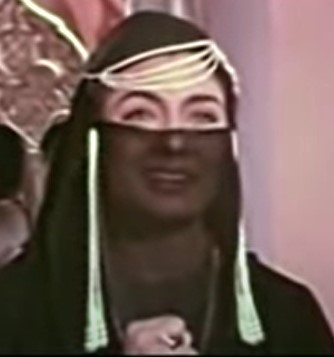
A few months ago while I was enjoying some old Marlene Dietrich clips, I thought that surely someone must have done a good remake of a Marlene Dietrich movie in Bollywood. After all, Marlene was a legendary cabaret star in both German and American cinema, and who knows cabaret better than the filmmakers in Bollywood? In the remake that I pictured, the Marlene role could be played by, say, Helen or Cuckoo, and the movie would be full of risque cabaret acts with the star doing lots of dances in those famous Marlene Dietrich stockings and other such kinky attire.
But when I finally discovered a remake of a Marlene Dietrich movie, it turned out to be something a bit different. In this remake of The Blue Angel, Marlene’s role is played by a full-figured 40-something Sandhya, and instead of doing cabaret acts, she does folk dances in a traveling Marathi dance troupe.
Admittedly, Pinjra isn’t an exact remake of The Blue Angel, as it strays near the middle into melodramatic twists that are very different from anything that would have come out of old Hollywood. And I wish I could pinpoint all the points of departure, but I admit that it’s been ages since I saw The Blue Angel, plus I’m not really sure I ever even saw the whole film. However, from what I know (and from the plot summaries that I peaked at) both films share this basic core of plot:
An esteemed teacher who is concerned about the moral threat to his students presented by a famously alluring dancer tries to take steps to eliminate this problem, such as going to the dancer’s show himself to make sure that his students aren’t frequenting it. Much to his own surprise, though, he ends up becoming more attracted to this dancer than anyone, and he enters into a romance with her that will lead to his own downfall.
In Pinjra, though, the teacher is a moral leader for an entire village, who must also interact with an official village leader and the official leader’s evil son. The official leader’s evil son becomes increasingly involved in conflict with the teacher (perhaps because the teacher tried to set him straight too many times) and repeatedly vows revenge. Meanwhile this same son is harassing a woman whom the teacher has been trying to protect from him, tries at one point to rape her, and ends up being killed in revenge by the woman’s husband right outside the teacher’s house. Coincidentally, just before this villain is killed, he has been trying to gain entry into the teacher’s house to expose the situation inside, i.e., a hotly brewing love affair between the teacher and the dancer (and a lot of anguishing along with it about the possible consequences of this forbidden romance).
When the teacher opens his door and finds his adversary lying outside, murdered, he and the dancer both realize that the young man’s face has been so smashed up (with a rock), it’s now unrecognizable. The dancer then comes up with the idea that they should mislead the people in the village into thinking that the unrecognizable victim is the teacher himself.

Since he is plauged by anguished thoughts that he needs to escape from the village (to avoid impending moral penalties for his forbidden romance, etc.), the teacher decides to accept this plan. Unfortunately, unlike probably any viewer of this movie, the wise teacher seems unable to guess the biggest risk involved in this trickery, that he might one day be arrested for the murder of himself. (And this might become a bigger risk if he ends up getting “caught” at a time when, for some reason, his own face has been somewhat disfigured, though that of course would be an awfully big and terrible coincidence…)
Now, readers here might correct me if they know differently, but once again, given what I know, The Blue Angel has none of this terrible and weird irony; the teacher just sort of experiences a moral downfall, becomes humiliated, and goes crazy.
The tragedies unfold in Pinjra in ways that are very typical of a Hindi movie (or in this case, a movie that was made in both Hindi and Marathi). Nonetheless, it is still all very involving and well paced, and the songs remain excellent throughout . ( I would like to hear more from this Marathi music director, Ram Kadam!)
I admit that I prefer the lighter, semi-comic half before the increasingly tragic half, and I think that this part of the movie was superbly done. Sandhya plays the seduction just perfectly, and Shreeram Lagoo – the Marathi actor who plays the teacher – does a fine job of portraying someone who is both highly educated and extremely innocent. Also during this part of the movie, it is fun to watch how the dancer, while seducing the teacher, actually falls for him because she is so charmed by his naivete.

During this part, I couldn’t help thinking of the relationship between the characters played by Waheeda Rehman and Raj Kapoor in the 1966 film Teesri Kasam. And since Waheeda’s character in that film is also the star of a traveling folk dance troupe that puts her into morally questionable situations, the parallels with this part of Pinjra get very close. (That’s right, as much as it is a remake of The Blue Angel, it could also be a remake of Teesri Kasam – well, during a small portion, anyway.)
But there is a nice added touch in this relationship in Pinjra, exactly because the naive guy is not some country bumpkin but, supposedly, very wise and educated. Conversely, the dancer surprises the teacher with her own intelligence, especially since his class prejudices cause him to expect less from a woman in her place. This, of course, adds to the love that he feels for her.
But on the negative side, Pinjra is far less quiet/subtle in its exposition, and it even sometimes lapses into cheezy melodramatic effects, such as blurred freeze frames at momentous moments in the teacher’s moral downfall – like when he starts succumbing to the temptation of tobacco…

For me, the film started to lose its appeal a little as the characters’ fates started spiiraling donward, but V. Shantaram’s direction remains pretty high-quality in most ways, and there wasn’t a moment when I felt myself getting bored or impatient. Moreover, Sandhya and Shreeram Lagoo continue to give truly excellent performances throughout. I was especially impressed by Sandhya’s acting in this movie, and I am sure now that in many corners (though not all) she has simply been very underrated.
Overall, it was a nice surprise to me that such a well done film with the V. Shantaram/Sandhya combination had come out in the early ’70s. As I recall reading, some thirteen years earlier, the critics were slamming Shantaram, and one even declared that he was “senile.” But despite those premature assessments, in this ’72 movie, Shantaram obviously still “had it,” while Sandhya was probably better than ever in some ways.
I must admit, though, that I don’t know how Pinjra would hold up in a comparison with its classic inspiration The Blue Angel (which I really have to see again, and in full, sometime). Despite the similarities in plot, they seem to be so different stylistically, I wonder if such a comparison is even truly possible.
———————
P.S. Although Pinjra came out in both Hindi and Marathi, it seems the only clips available for posting are in Marathi. But that’s OK, because it’s interesting – you won’t see Marathi songs very often here or in any Bollywood blog. Also, I wanted to mention that while it might be a little annoying to keep seeing references to the “dancer” and “teacher” rather than to actual names, that is often how they are referred to in the film. (And even in cast lists at IMDb, etc., they are referred to as “dancer” and “teacher” rather than by name.)




Had somehow missed out on this post.
Although the plot in the Blue Angel and Pinjra might be same in the beginning, the major difference is in the handling of the film. In the Blue Angel (I saw the German version), the main theme for me was the hypocrisy of the teacher Professor Unrat. It follows the old theme of downfall of a man because of a ‘loose’ woman just like in the opera Carmen.
But in the movie ‘the Blue Angel’ the variete singer is never in love with the professor. The professor tries to bring his middle class moralities in his new relationship, which are quite unknown to Lola. The professor dies full of remorse in his classroom clutching his blackboard if I remember right.
Shantaram’s movie is very moralistic about the situation. The Professor/teacher is seduced by the dancer, but he would never have left his ‘good ways’, if it was not to protect his image in front of the villagers. His main concern remains ‘the welfare of the villagers’. In Pinjra the seducer is the one who gets seduced at the end. And like every whore with a golden heart on the silver screen, she has to pay for it with her life.
The dancer envies the teacher’s innocence and his morals. It would added a nice angle to the story if the teacher could have admired the dancer’s independence and strong will.
“it might be a little annoying to keep seeing references to the “dancer” and “teacher”
A teacher in India would always be adressed as Masterji or something equivalent leaving the translator with no other option than to translate it as teacher.
And the dancer I think would have been referred to as Bai, an english equivalent would be hard to find for this word, thus the dancer.
“I would like to hear more from this Marathi music director, Ram Kadam”
I read somewhere that Ram Kadam had to provide V. Shantaram with nearly 100 tunes from which he choose twelve.
I love the music from this movie. Wonder how they sound in Hindi though!
The correct citation about Pinjra songs:
Trivia about Pinjra songs:
Jagadish Khebudkar, the lyricist informs us that he wrote 110 songs for
the film, Ram Kadam set up 135 tunes for them. Of these, V.Shantaram
chose 11 ! ‘Tumhavar keli mee marzi bahaal’ had 49 failed attempts, he
says, and the 50 th one was approved!
http://www.esakal.com/esakal/esakal/05082006/rightframe.html
…Pradeep
And some more trivia form rec.muisc.indian.misc
Jagadish Khebudkar celebrated his 74 th birthday.
So he was felicitated in Mumbai and Thane last week end. The link I
provided was one account of his felicitation at Thane, where he
reminisced his time as a lyricist. He elaborated a bit on those 49
attempts to write a laavni, sitting at Rajkamal throughout the day,
creating a new one only to be rejected by V. Shantaram. ‘Late into the
night, I felt quite dejected’ he said. ‘Shantaram bapu wanted a laavni
that would captivate the audience, and all I was presenting him through
the day didn’t appeal to him. My creativity was at stake and I was
quite worried’. Then, just as Shantarambapu called up suggesting that I
retire for the day and make a fresh beginning the next day, this laavni
‘Tumhavar keli mee marzi bahaal’ sprung up into my mind out of
nowhere’. Shantarambapu promptly approved of it’ and the rest is
history.
……..Pradeep
Harvey,
Thanks for all that interesting information. Regarding comments about how it would have been more interesting if the teacher admired the dancer’s independence and strong will… Well, that’s true, and he doesn’t seem to by any stretch. But he does seem to admire her natural intellgience at some point, thinking of her as being remarkably poetic for someone so unschooled, etc. But I guess that’s kind of a qualified admiration, since it’s based on low expectations based on his class prejudices. It did make for a mildly interesting social comment, though.
I have noticed that in some Indian films certain people are addressed only by vocation, as though vocation completely replaced names. I would find that very annoying… I am always for less identification of people based on the things they do for a living (since so many other things go into the makeup of our identities), but in India, there often seems to be even more. (I guess old Indian feudalism – castes – contributes to this tendency, in addition to the regular “bourgeois division of labor” described by the writer/philosopher favored by a few old Indian actors and directors. :)
It’s not too surprising that Shantaram was such a perfectionist with the music, picking so few songs out of so many (one out of ten). We’ve already seen that he was a very demanding perfectionist in terms of dance (causing Sandhya some stays in the hospital, etc.), so naturally he would be for music too. Judging by a few of his films, though, maybe he wasn’t so perfectionist about scripts. (Not that he didn’t also have very good ones – still one of my favorite directors overall – but still…)
By the way, were you saying that the second site was at http://rec.music.indian.misc ? (Assuming you meant “music” and not “muisc” :) … I had no luck trying to call that up; the “diagnosis” was that there was no site by that name.
You are right about expecting things from filmi characters.
What I liked about der blaue engel was the fact, which the director showed the different mileus the characters come from. Two worlds clash with each other, each one trying to impose one’s own image of the world on the other.
In Pinjra, I’d a feeling that the director is taking sides with the teacher. And the fact that the dancer leaves her troupe (does she? As far as I remember, she at least quarrels with her mother or something similar) or the transformation in her is to be attributed to the strong moral character of the teacher.
rec.music.indian.misc is a newsgroup and not a site.
Go to http://groups.google.at/group/rec.music.indian.misc/topics and search there for the topic
‘Pinjara & Jait re Jait songs & Hridaynath Mangeshkar’
“I have noticed that in some Indian films certain people are addressed only by vocation”
Interesting commentary you made on this topic. I had to smile at your last line.
That is true. I won’t like to be addressed by my vocation. But in India at times your denial to be addressed so might raise many a eyebrows, because people might misinterpret that you want something more. Like if a girl calls you brother and you express your discomfort at that, people would think that you have ulterior motives. Same thing applies to teacher and so on. They way you are addressed defines the relationship with that person.
WHY YOU PEOPLE TRY TO DRAW PARALLELS WITH BLAU ANGEL… IT IS SOME WHAT LOSELY BASED ON VIPRANARAYANA STORY. SHANTARAM IS KNOWN FOR HIS SOCIALISATION THEMES OF MYTHOLOGICALS AND HISTORICALS. VIPRANARAYAN IS A FERVENT DEVOTEE OF VISHNU. HE NEGLECTS BEAUTY AND ADVANCES OF DEVADEVI, A DANCER. THE ARROGANT DANCER VOWS TO SEDUCE THE BHAKTA AND SUCCEEDS. THE SAME STORY WAS TOLD IN A DIFFERENT MANNER BY THE GREAT CINEMAMASTER.
HE HAS TAKEN THE STORY OF JAKKANACHARYA, THE FAMOUS SCULPTOR OF VIJAYANAGARA EMPIRE AND PRODUCED A MASTERPIECE CALLED GEETH GAYA PATHARONE. THE TIMES ARE DIFFERENT BUT BASICSTORY LINE IS SAME.
Thanks Raghu for the ifo that is quite interesting. For a person not well-read in Indian classic literature, it is difficult to see the parallels.
Anant Mane was a prolific director of Marathi films. He also considered Shantaram his guru. About Pinjra (1972), Mane recalls in his autobiography that Shantaram requested him to make a film for his production house giving him full freedom in terms of story etc. Shantaram laid down only one condition- the film should have Sandhya. Mane worked on the script, but also felt that he owed his guru a gurudakshina ( a token of respect for one’s teacher) and therefore insisted, despite his many successful hits. experience and reputation that he will assist Shantaram on the sets- be his assistant director- and so it was. Mane states that his script was inspired by a foreign film – although he doesn’t name Blue Angel. I had seen Blue Angel many years ago and then when I saw Pinjra a few year after I was immediately struck by the similarity. Of course there are those differences that you all point out – in terms of its melodramatic aesthetic as well as the way Blue Angel is adapted but the influence is undeniable!! I chanced upon this discussion because I am writing about Marathi films, particularly of the tamasha genre.
Aarti, thanks for adding all this good information from your unique perspective. It’s funny that Shantaram’s only condition for the making of the film was that it starred his wife. :) Anyway, please feel free to send more info from your writings and studies of Marathi films. I don’t know much about Marathi films except from the perspective of being a fan of Shantaram and Sandhya. I think a couple of readers of this blog might know more, though most know mainly about Hindi films (that being “Bollywood,” etc.). But it would be a good subject to learn more about…